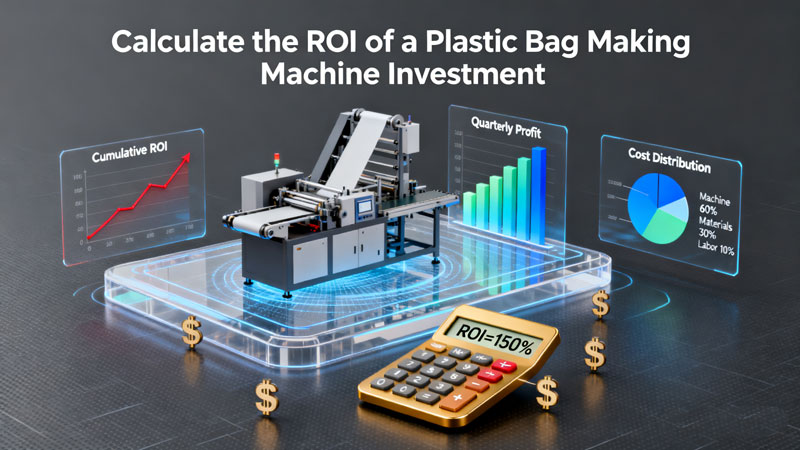Thinking of investing in a plastic bag making machine? Our expert guide breaks down the ROI calculation with real-world examples, cost factors, and how RUIKANG machines ensure a faster payback period.

So, you're considering investing in a plastic bag making machine to start or expand your business. The first and most critical question that likely comes to mind is, "How long will it take for this machine to pay for itself and start generating profit?" This is the essence of calculating your Return on Investment (ROI). For business owners and plant managers, this isn't just a financial exercise; it's about validating a strategic decision that impacts production capacity, market competitiveness, and long-term growth. In this comprehensive guide, we will demystify the ROI calculation process, providing you with a clear, step-by-step framework to confidently assess the financial viability of your investment, with a specific focus on the value proposition of RUIKANG machinery.
Before you can calculate your return, you must first understand the total cost of ownership. This goes far beyond the simple price tag of the plastic bag making machine.
Capital Expenditure (CapEx): This is your initial outlay. It includes the cost of the high-speed machine itself, any essential customization, installation fees, and initial training for your operators. A RUIKANG T-shirt bag machine, for instance, might have a different base price than a grocery bag making machine due to its specific mechanisms.
Operational Expenditure (OpEx): These are the recurring costs of running the equipment. Key factors include:
Raw Material Consumption: The type and grade of polyethylene (HDPE, LDPE, LLDPE) film you use is your largest ongoing cost. The machine's efficiency directly impacts material waste.
Energy Consumption: A modern, energy-efficient RUIKANG machine can significantly reduce your electricity bills compared to an older, less efficient model.
Labor Costs: While automated plastic bag making machines require fewer operators, you still need to account for their salaries.
Maintenance and Spare Parts: Regular servicing is crucial. RUIKANG's reputation for durability and readily available spare parts helps keep these long-term costs predictable and low.
On the other side of the equation is the income your new asset will generate. Accurate projection is key.
Increased Production Output: The primary driver of revenue. A new high-speed plastic bag making machine from RUIKANG can dramatically increase your output. For example, if your current machine produces 200kg of bags per shift, a new model might produce 300kg, a 50% increase.
Product Diversification and Premium Pricing: Can the new machine produce higher-margin products? Perhaps it allows you to manufacture carry bags with reinforced handles or printed designs, which command a higher price per unit than plain grocery bags.
Reduction in Defect Rates: Modern machinery with advanced control systems significantly lowers the percentage of defective bags. This reduction in waste directly translates into more saleable products and higher revenue from the same amount of raw material.
Now, let's put it all together. The basic formula for ROI is:
ROI (%) = (Net Profit / Total Investment) × 100
But let's make it practical for a plastic bag making machine:
Calculate Annual Net Profit:
Estimate Annual Revenue: (Bags produced per hour) x (Operating hours per year) x (Price per bag).
Subtract Annual Total Costs: (Raw material cost + Labor + Energy + Maintenance).
The result is your Annual Net Profit.
Determine Total Investment: This is your total CapEx, as outlined above.
Plug into the Formula:
ROI = (Annual Net Profit / Total Investment) x 100.
Scenario Example: Imagine you invest $50,000 in a new RUIKANG bag making machine. In the first year, it generates an additional $70,000 in net profit after all costs.
ROI = ($70,000 / $50,000) x 100 = 140%
This means you've recouped your initial investment and earned a 40% profit on top of it in the first year. The payback period would be just under 9 months.
Choosing the right manufacturer is not just about the machine's price; it's about its total value. RUIKANG integrates features designed to maximize your ROI:
Superior Energy Efficiency: Our machines use servo motors and optimized heating systems that can reduce power consumption by up to 30% compared to conventional models, directly lowering your OpEx.
Minimized Material Waste: Precision control systems ensure consistent bag dimensions and seal integrity, reducing film waste to often less than 2%.
Unmatched Uptime and Reliability: Built with robust components and rigorous testing, RUIKANG plastic bag manufacturing equipment is engineered for continuous operation, minimizing costly production downtime.
Customization for Your Market: We don't just sell a standard machine. We work with you to customize the equipment for your specific film type and bag specifications, ensuring you can produce the most profitable products for your local market.
Investing in a plastic bag making machine is a significant step. By thoroughly understanding the costs, projecting revenues realistically, and partnering with an engineering-focused brand like RUIKANG, you can make a data-driven decision that fuels your business growth.
Ready to get a precise ROI calculation tailored to your production needs? Contact the RUIKANG experts today for a free, no-obligation consultation and a detailed quote for the ideal bag making machine for your factory.
>> Explore RUIKANG's High-ROI Plastic Bag Making Machines Here <<
This article was crafted with the assistance of AI to ensure data accuracy and comprehensiveness, and was subsequently reviewed and refined by our industry experts to meet human editorial standards.